ARCHAEOLOGY
PAPER – III
Note : This paper contains seventy five (75) objective type questions of two (2) marks each. All questions are compulsory.
1. Rock paintings in India generally help to reconstruct life ways of
(1) Middle Palaeolithic
(2) Mesolithic
(3) Neolithic
(4) Chalcolithic
2. The term Palaeolithic was coined by
(1) Daniel Wilson
(2) L.H. Morgan
(3) John Lubbock
(4) Sven Nilson
3. The term ‘Neolithic’ was coined by
(1) John Lubbock
(2) Daniel Wilson
(3) E.B. Tylor
(4) Charles Lyell
4. A copper knife was found in the middle levels of the Mesolithic occupation from which of the following site ?
(1) Bagor
(2) Bhimbetka
(3) Morhana Pahar
(4) Langhnaj
5. A stone blade core with incised lattice design is known from which of the following site ?
(1) Chandravali
(2) Patne
(3) Ghargaon
(4) Baghor
6. A four-fold scheme for the Stone Age, classified into series from 1 to 4 was proposed by
(1) H.D. Sankalia
(2) Robert Bruce Foote
(3) Deterra and Patterson
(4) Cammiade and Burkit
7. Evidence of antler rings used as earrings have found from which of the following site ?
(1) Mahadaha
(2) Damdama
(3) Langhnaj
(4) Chopani Mando
8. Gold ornaments are reported from which of the following Megalithic burials ?
(1) Brahmgiri
(2) Mahurjhari
(3) Junapani
(4) Paunar
9. Potassium Argon method of dating is used to date
(1) Bones
(2) Pottery
(3) Wood
(4) Volcanic ash
10. Which site has revealed complete cultural sequence from the Neolithic to mature phase of Harappan civilization ?
(1) Dholavira
(2) Rakhigarhi
(3) Kalibangan
(4) Mehargarh
11. Which of the following method would be suitable for determining the dating of baked clay remains ?
(1) Varve analysis
(2) Carbon-14
(3) Thermoluminescence
(4) Potassium Argon
12. ‘Shyenchiti’ was found at which of the following sites ?
(1) Thanesar
(2) Shringverpur
(3) Mathura
(4) Kaushambi
13. Durjanapur Tirthankar images were carved during the reign of the following :
(1) Chandragupta I
(2) Ramagupta
(3) Purugupta
(4) Skandagupta
14. Which of the following Asokan inscriptions informs us about the provision made for the treatment of men and animals ?
(1) Rock Edit II
(2) Rock Edit V
(3) Rock Edit XII
(4) Rock Edit XIII
15. When did Bodhisattva images begin to be sculptured ?
(1) 1st Century A.D.
(2) 4th Century A.D.
(3) 3rd Century B.C.
(4) 4th Century B.C.
16. Who among the following introduced coins bearing dates ?
(1) Chandragupta II
(2) Kanishka I
(3) Rudrasena I
(4) Rudrasimha I
17. According to the Arthasastra, who among the following was responsible for issuing coins ?
(1) Lakshanadhyaksha
(2) Panyadhyaksha
(3) Rupyadhaksha
(4) Sauvarnika
18. Which of the following inscriptions makes first reference to prathama kayashta ?
(1) Eran Stone Pillar Inscription of Skandagupta.
(2) Damodarpur Copper Plate Inscription of Kumaragupta I.
(3) Bhitari Stone Pillar Inscription of Skandagupta.
(4) Mandasore Stone Pillar of Bandhuvarma.
19. Who among the following had done first major work on pillared hall at Pataliputra ?
(1) D.B. Spooner
(2) A.S. Altekar
(3) Vijay Kant Mishra
(4) Mortimer Wheeler
20. Which of the following sites are marked by factory-cum-occupation floor of the Lower Palaeolithic period ?
a. Maihar I on Lilji river
b. Daiya on Belan river
c. Anagwadi on Ghataprabha river
d. Chirki on Pravara river
Codes :
(1) a and b
(2) b and c
(3) b and d
(4) a and d
21. The paintings in Bhimbetka caves are executed in which of the following colours ?
a. Red
b. Green
c. Blue
d. White
Codes :
(1) a, b and c
(2) a, b and d
(3) a, c and d
(4) b, c and d
22. The Neolithic sites yielding human skeletons are
a. Budihal
b. Chirand
c. Jhusi
d. Piklihal
Codes :
(1) a and b
(2) b and c
(3) c and d
(4) a and d
23. The Mesolithic sites, which yielded human skeletons are
a. Morahana Pahar
b. Baghaikhov
c. Lakhania
d. Ghagharia
Codes :
(1) a and b
(2) b and c
(3) c and d
(4) a and d
24. The evidence of domesticated animals were obtained from which of the following sites ?
a. Bagor, Rajasthan
b. Paisra, Bihar
c. Damdama, Uttar Pradesh
d. Adamgarh, Madhya Pradesh
Codes :
(1) a and b
(2) b and c
(3) c and d
(4) a and d
25. Prehistoric paintings have been found from which of the following sites ?
a. Lascaux in France
b. Dolni Vestonice in Czechoslovakia
c. Altamira in Spain
d. La Moustier in France
Codes :
(1) a and b
(2) a and c
(3) a and d
(4) b and d
26. Which of the following sites have produced information on the presence of horse ?
a. Lothal
b. Jalilpur
c. Pirak
d. Surkotada
Codes :
(1) a and c
(2) b and d
(3) c and d
(4) d and a
27. Which of the following sites are associated with Copper Hoards ?
a. Bisauli
b. Rajpur Parsu
c. Noh
d. Shringverpur
Codes :
(1) a and b
(2) b and c
(3) c and d
(4) a and d
28. Consider the following pairs :
(i) Ayodhya Stone Inscription of Dhanadeva – Senapati Pushyamitra.
(ii) Besnagar Garudadwaja Pillar Inscription – Dimita
(iii) Mandasor Stone Inscription of the time of Kumaragupta I and Bandhuvarman – Vatsabhatti
(iv) Udaigiri Cave Inscription of Chandragupta II – Virasena Saba
Which of the above pairs are correctly matched ?
Codes :
(1) (i), (ii) and (iii)
(2) (i), (iii) and (iv)
(3) (ii), (iii) and (iv)
(4) (iii) and (iv) only
29. Which of the following archaeological sites were excavated by A.S. Altekar ?
a. Vaisali
b. Pataliputra
c. Chirand
d. Rajgir
Codes :
(1) a and d
(2) c and d
(3) a and b
(4) b and d
30. Which of the following inscriptions make references to provision for relief to the draughtstricken people by the State ?
a. Damodarpur Copper Plate Inscription
b. Mahasthan Inscription
c. Junagarh Rock Inscription of Skandagupta.
d. Sohgaura Copper Plate Inscriptions.
Codes :
(1) a and b
(2) b and d
(3) b and c
(4) a and d
31. Which of the following Ports were situated on the eastern coast of India ?
a. Kaveripattanam
b. Korkai
c. Musiri
d. Tondi
Select the correct answer from the code given below :
Codes :
(1) a only
(2) a and b
(3) c only
(4) c and d
32. Which of the following inscriptions refer to the irrigational works ?
a. Bhitari Stone Pillar inscription of Skandgupta.
b. Hathigumpha inscription of Kharavela.
c. Ashoka’s Minor Pillar inscription of Rummindei.
d. Girnar Rock inscription of Rudradaman – I.
Codes :
(1) a and c
(2) b and d
(3) a and d
(4) b and c
33. Which of the following stupas belong to the Sunga period ?
a. Bharhut
b. Amaravati
c. Nalanda
d. Sanchi
Codes :
(1) a and c
(2) a and d
(3) b and c
(4) b and d
34. Consider the following statements :
Assertion (A) : In Indian Mesolithic phase there is spread of-settlements to new ecological regions.
Reason (R) : This may be as a result of an increase in population due to more favourable environmental conditions and also technological innovations.
Codes :
(1) (A) and (R) both are correct and (R) is correct explanation of (A).
(2) (A) and (R) both are correct, but (R) is not correct explanation of (A).
(3) (A) is correct and (R) is wrong.
(4) (A) is wrong and (R) is correct.
35. Consider the following statements :
Assertion (A) : Archaeological evidence does not necessarily provide a complete picture of the material culture of ancient people.
Reason (R) : Not all materials survive.
Codes :
(1) (A) and (R) both are correct and (R) is correct explanation of (A).
(2) (A) and (R) both are correct, but (R) is not correct explanation of (A).
(3) (A) is correct and (R) is wrong.
(4) (A) is wrong and (R) is correct.
36. Consider the following statements :
Assertion (A) : Archaeological sites are places where material remains of past human activity can be identified.
Reason (R) : Field archaeology deals with the exploration and excavation of sites.
Codes :
(1) (A) and (R) both are correct and (R) is correct explanation of (A).
(2) (A) is correct and (R) is wrong.
(3) (A) and (R) both are correct, but (R) is not correct explanation of (A).
(4) (A) is wrong and (R) is correct.
37. Consider the following statements :
Assertion (A) : Rock art forms a direct and valuable source of the cognitive and cultural evolution of humankind.
Reason (R) : India is one of the countries having the richest treasure of rock art in the world.
Codes :
(1) (A) and (R) both are correct and (R) is correct explanation of (A).
(2) (A) and (R) both are correct, but (R) is incorrect explanation of (A).
(3) (A) is correct but (R) is incorrect
(4) (A) is incorrect, but (R) is correct.
38. Consider the following statements :
Assertion (A) : Iron was a common knowledge during the Harappan period.
Reason (R) : It is found as an attachment with some of the copper tools of this period.
Codes :
(1) (A) is wrong, but (R) is correct.
(2) Both (A) and (R) are incorrect.
(3) Both (A) and (R) are correct and (R) is the correct explanation of (A).
(4) Both (A) and (R) are correct but (R) is the incorrect explanation of (A).
39. Consider the following statements :
Assertion (A) : Camel was the main source of traction power during the Harappan period.
Reason (R) : This animal was commonly present during this period.
Codes :
(1) (A) is wrong, but (R) is correct.
(2) Both (A) and (R) are wrong.
(3) Both (A) and (R) are correct and (R) is the correct explanation of (A).
(4) Both (A) and (R) are correct, but (R) is the incorrect explanation of (A).
40. Consider the following statements :
Assertion (A) : There was a close connection between the Chalcolithic settlements of Maharashtra and the Harappan settlements
Reason (R) : The areas of both the cultures were contiguous to each other.
Codes :
(1) Both (A) and (R) are correct, but (R) is the incorrect explanation of (A).
(2) Both (A) and (R) are correct and (R) is the correct explanation of (A).
(3) Both (A) and (R) are incorrect.
(4) (A) is wrong but (R) is correct.
41. Consider the following statements :
Assertion (A) : The Black and Red wave captured the most parts of the Indian subcontinent.
Reason (R) : The technique of making this pottery was easy and known everywhere.
Codes :
(1) Both (A) and (R) are correct, but (R) is incorrect explanation of (A).
(2) Both (A) and (R) are correct and (R) is correct explanation of (A).
(3) Both (A) and (R) are wrong.
(4) (A) is correct, but (R) is incorrect.
42. Consider the following statements :
Assertion (A) : The average size of the Kushana settlements is big.
Reason (R) : The climatic conditions wave favourable for this.
Codes :
(1) Both (A) and (R) are correct, but (R) is wrong explanation of (A).
(2) Both (A) and (R) are correct and (R) is correct explanation of (A).
(3) Both (A) and (R) are wrong.
(4) (A) is wrong, but (R) is correct.
43. Consider the following statements :
Assertion (A) : The second urbanization was more concentrated in the Ganga plain than the Indo-Gangetic plain.
Reason (R) : It started from the Ganga plain only.
Codes :
(1) Both (A) and (R) are correct, but (R) is not the correct explanation of (A).
(2) Both (A) and (R) are correct and (R) is the correct explanation of (A).
(3) Both (A) and (R) are wrong.
(4) (A) is wrong, but (R) is correct.
44. Consider the following statements :
Assertion (A) : Majority of the Megalithic settlements are temporary.
Reason (R) : The natural landscape was highly suited for pastoral activities.
Codes :
(1) Both (A) and (R) are correct, but (R) is not the correct explanation of (A).
(2) Both (A) and (R) are correct and (R) is the correct explanation of (A).
(3) Both (A) and (R) are wrong.
(4) (A) is wrong, but (R) is correct.
45. Consider the following statements :
Assertion (A) : About 45 A.D. Hippalus, an Alexandrian merchant, discovered the phenomenon of monsoon, which made it possible for mariners to cross the Arabian sea in a much shorter time.
Reason (R) : This gave considerable fillip to trade between South India and South-East Asia.
In the context of the above which of the following is correct ?
Codes :
(1) Both (A) and (R) are true and (R) is the correct explanation of (A).
(2) Both (A) and (R) are true, but (R) is not the correct explanation of (A).
(3) (A) is true, but (R) is false.
(4) (A) is false, but (R) is true.
46. Consider the following statements :
Assertion (A) : David Diringer has propounded that Armaic script is the source of nearly all scripts in the world.
Reason (R) : It is proved by the fact that Achaemenian rulers of Iran started using Armaic as the state script in India.
Codes :
(1) Both (A) and (R) are correct.
(2) (A) is correct and (R) is wrong.
(3) (A) is correct and explanation (R) to (A) is also correct.
(4) Both (A) and (R) are wrong.
47. Consider the following statements :
Assertion (A) : The silver coins were issued in large number by the Imperial Guptas in Western India.
Reason (R) : It was intended to win the confidence of the people who were conquered by the Gupta kings.
Codes :
(1) Both (A) and (R) are correct and (R) is the correct explanation of (A).
(2) Both (A) and (R) are correct, but (R) is not the correct explanation of (A).
(3) (A) is correct, but (R) is false.
(4) (A) is false, but (R) is correct.
48. Consider the following statements :
Assertion (A) : Coins throw light on the religious leaning of the issuer.
Reason (R) : They bear devices pertaining to different religions.
Codes :
(1) (A) is correct, but (R) is incorrect.
(2) Both (A) and (R) are correct and (R) is the correct explanation of (A).
(3) Both (A) and (R) are correct and (R) is incorrect explanation of (A).
(4) (A) is incorrect, but (R) is correct.
49. Arrange the following in chronological order :
a. Camasian
b. Kanjeran
c. Kageran
d. Gamblian
Codes :
(1) c, a, b, d
(2) c, b, a, d
(3) b, c, a, d
(4) b, c, d, a
50. Arrange the following human types in chronological order :
a. Homo heidelbergensis
b. Homo ergaster
c. Paranthropus boisei
d. Homo neanderthalensis
Codes :
(1) c, b, a, d
(2) c, b, d, a
(3) b, c, d, a
(4) a, b, d, c
51. Arrange the following implements in chronological order :
a. Burin
b. Sling ball
c. Cleaver
d. Borer
Codes :
(1) d, c, a, b
(2) d, b, c, a
(3) c, d, a, b
(4) c, d, b, a
52. Arrange the following in chronological order :
a. Excavations at Hemmige
b. Piklihal Excavations
c. Excavations at Sanganakallu
d. Utnoor Excavations
Codes :
(1) b, c, a, d
(2) c, a, b, d
(3) b, d, c, a
(4) d, b, a, c
53. Arrange the following objects in chronological order :
a. Wedge-shaped bricks
b. Sun dried bricks
c. Circular huts
d. Mud houses
Codes :
(1) d, c, b, a
(2) c, b, a, d
(3) b, d, c, a
(4) c, d, b, a
54. The inscriptions found from which of the following sites represents a provincial variety of early Brahmi in the South ?
(1) Arikamedu
(2) Badami
(3) Bhattiprolu
(4) Kanchi
55. Arrange the following cultures in chronological order :
a. Painted Grey Ware
b. Kayatha
c. Early Harappan
d. Northern Black Polished Ware
Codes :
(1) a, d, c, b
(2) b, c, d, a
(3) d, a, b, c
(4) c, b, a, d
56. Arrange the following Stupas in the chronological order :
a. Amaravati
b. Bodhgaya
c. Dhamek
d. Sanchi
Select the correct answer from the code given below :
Codes :
(1) d, b, c, a
(2) a, b, c, d
(3) b, c, d, a
(4) d, b, a, c
57. Arrange the following in chronological order :
a. Hindu-Shahi coins of Ohind and Afghanistan
b. Standard type coins
c. Apratigha type coins
d. Chakravikrama type coins
Codes :
(1) b, d, c, a
(2) a, b, c, d
(3) d, c, a, b
(4) c, b, d, a
58. Arrange the following temples in chronological order :
a. Bhitargaon Temple
b. Deogarh Temple
c. Lakshmana Temple, Sirpur
d. Sanchi Temple 17
Codes :
(1) d, b, c, a
(2) d, b, a, c
(3) c, d, a, b
(4) b, a, c, d
59. Arrange the following temples in chronological order :
a. Virupaksha temple
b. Chaunsatha Yogini temple
c. Kandaria Mahadeva temple
d. Meguti temple
Codes :
(1) a, d, b, c
(2) c, b, a, d
(3) c, b, d, a
(4) d, a, b, c
60. Arrange the following inscriptions in chronological order :
a. Rummindei Minor Pillar Inscription
b. Girnar Rock inscription of Rudradaman I
c. Gwalior inscription of Mihirabhoja
d. Mandsore Pillar inscription of Yashodharman
Codes :
(1) b, a, c, d
(2) a, b, d, c
(3) c, d, b, a
(4) d, c, a, b
61. Arrange the following in chronological order :
a. Bhitari Stone Pillar Inscription
b. Besnagar Garuda Pillar Inscription
c. Lumbini Pillar Edict
d. Swat Relic Casket Inscription
Codes :
(1) d, b, c, a
(2) a, b, c, d
(3) c, b, a, d
(4) c, d, b, a
62. Match the items of List-I with those of List-II and choose the correct answer from the codes given below :

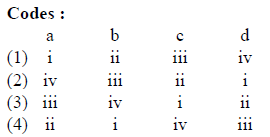
63. Match the items of List-I with those of List-II and choose the correct answer from the codes given below :

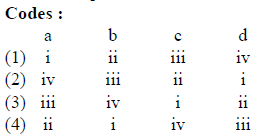
64. Match the items of List-I with those of List-II and choose the correct answer from the codes given below :


65. Match the items of List-I with those of List-II.

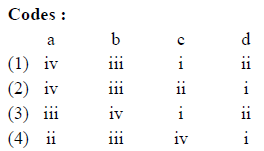
66. Match the items of List-I with those of List-II and choose the correct answer from the codes given below :
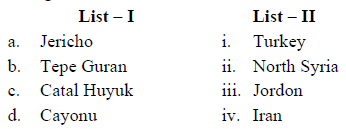

67. Match the items of List-I with those of List-II.


68. Match the sites of List-I with the river valleys of List-II.

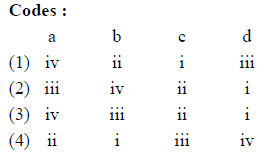
69. Match the sites of List-I with the river valleys of List-II.
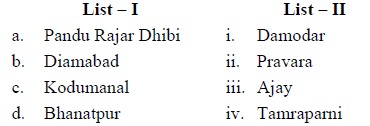

70. Match the sites of List-I with the excavators valleys of List-II.


71. Match List-I with List-II and select the correct answer from the codes given below :


72. Match the authors of List-I with their books of List-II.

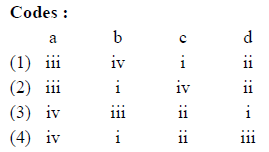
73. Match the authors of List-I with their books of List-II.

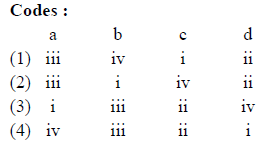
74. Match the books of List-I with the author of List-II.

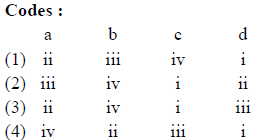
75. Match the items of List-I with those of List-II and select the correct answer from the codes given below the lists :


Latest Govt Job & Exam Updates: